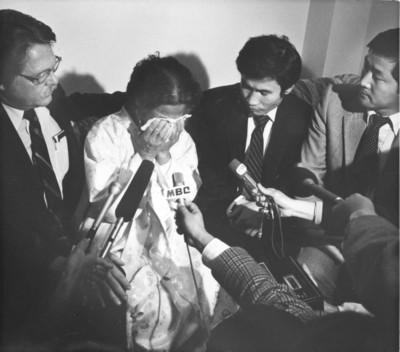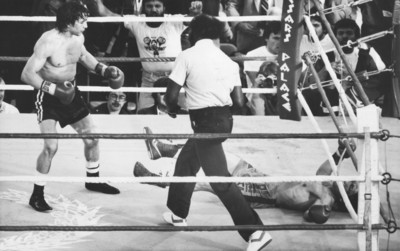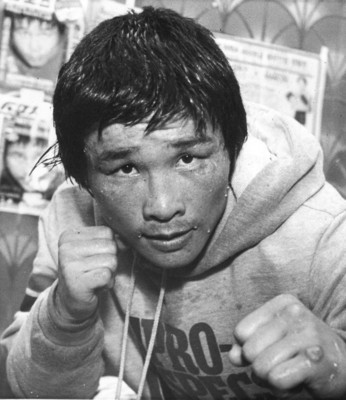‘It was a brutal fight’
The punches kept coming and coming. One after another. Thirty-nine in all. Duk Koo Kim absorbed every one of those 39 punches on Nov. 13, 1982.
Four days later, he was dead.
The young Korean fighter wasn't the first boxer to die as a result of injuries suffered in the ring. Nor was he the last. But 25 years later, those who watched Kim battle Ray "Boom Boom" Mancini for 14 rounds in the outdoor arena at Caesars Palace, remember vividly a day that would cause a national debate over the very existence of boxing and ultimately bring change to the sport.
"It was a very tragic time," said Sig Rogich, then chairman of the Nevada Athletic Commission. "Nobody knew how seriously hurt he was but he had taken quite a beating.
"It's a sad thing. (Kim) was a nice young man."
That day and the aftermath will be relived at 5 p.m. today when Mancini speaks candidly about the fight for the first time on a documentary about his career on ESPN Classic (Cable 322).
"November 13 is a day of grieving for me," Mancini said in excerpts from the documentary provided by ESPN. "I grieve for that day in remembrance of Kim and his family. And I always will."
Mancini said he has been troubled by two things:
Why did Kim die and not him? After all, Mancini had absorbed tremendous punishment during the fight.
And, Kim's death affected Mancini's own family, with members being targeted as a result of what had happened in the ring.
"What really tortured me that night was it could have been me," Mancini said. "I was looking at my hands going, 'I can't believe I did that.'
"My faith in God is the only thing that carried me through that. I said my prayers, 'God, please help me to find the answers, whatever, please. I need answers. Help me to find the peace in this.' ''
That Mancini's family was connected to Kim's death by some bothered him deeply.
"My daughter was in grade school and the kids were taunting her, 'Your father is a murderer. Your father is a murderer,' " he said. "No child should be responsible for the sins of the father. That's what bothered me the most and tell you the truth, that's the reason why I'm doing this right now."
Mancini was defending his WBA lightweight title for the second time when he climbed through the ropes at Caesars that Saturday afternoon. The popular fighter from Youngstown, Ohio, was building a national following. The fight was being shown on CBS and those who tuned in got more action than they bargained for.
"It was a brutal fight," said Royce Feour, the former boxing writer for the Review-Journal who was ringside at the fight. "Kim was getting hit a lot, but he was giving as well and he would score. But Mancini was scoring a little better.
"Before the fight, and this is so ironic, I had interviewed Kim in his hotel room at Caesars and I noticed something on a lampshade. It was writing in Korean and when I asked the interpreter what it meant, he said it meant roughly, 'Live or Die.' That has always stuck with me when I think about that fight."
In the 13th round, Mancini unleashed a barrage of 39 straight punches. Somehow, Kim survived the round.
Early in the 14th, Mancini connected with two big rights to Kim's head and the Korean dropped to the canvas. He beat the count of 10, but referee Richard Green stopped the fight.
Kim's dazed look was an immediate sign of trouble. Jim Hunter, who covered the fight for Reuters, said one could feel a change in the mood among the fans.
"Before the bout, there was almost a festive atmosphere," Hunter said. "But at the end, there was a noticeable pall over the crowd. They filed out quickly knowing they had seen something they wish they hadn't seen."
Kim was carried out of the ring by stretcher and rushed to Desert Springs Hospital. He was quickly prepared for surgery, and neurosurgeon Dr. Lonnie Hammargren removed a blood clot that had lodged in his brain.
Then the waiting began.
"(Kim) was extremely bad when he came in," Hammargren said. "I've probably operated on more boxers for blood clots in the head than any other doctor in the world and this guy was in bad shape."
Hammargren said saving Kim was going to be an uphill battle.
"I don't know if I was being courageous or just dumb, but I believed I could save him," he said. "You don't know in the instant you're operating whether someone will make it or not. But even if the odds were just 1 or 2 percent, you try."
Kim lapsed into a coma and was put on life support. In South Korea, debate soon arose over an American surgeon operating on one of the country's sports heroes. However, after the fighter died on Nov. 17, representatives of the South Korea government thanked Hammargren for his efforts.
"That meant a lot to me," he said. "I did everything I could to save (Kim)."
Then came a tumultuous aftermath. Four months after rushing to son's bedside in Las Vegas, Kim's mother committed suicide. Less than a year after the fight, Green, the referee, took his life. Mancini suffered from depression and was never the same fighter again, though he continued to box until 1993.
The fight prompted several changes to the sport. Fights were reduced from 15 rounds to 12. The standing eight count was introduced. Fewer fights were shown on network TV as cable and pay-per-view would take over the sport.
"There was a lot of byproduct from that fight," Rogich said. "The sport went on, but it's something I'll never forget."
Contact reporter Steve Carp at scarp@reviewjournal.com or (702) 387-2913.





















